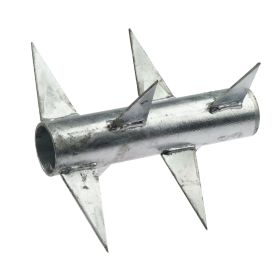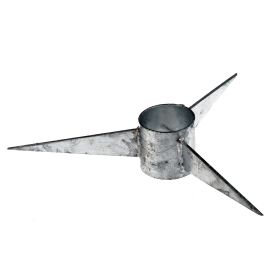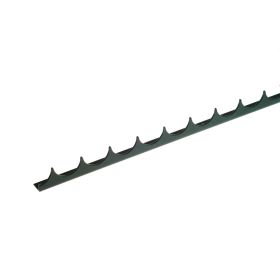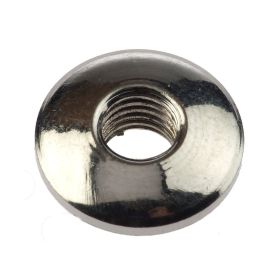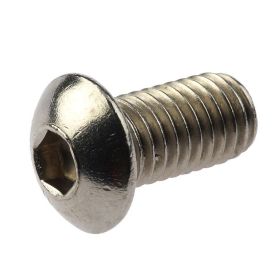Our security fencing products
Rotary Spike 230 mm Hot Dip Galvanised Steel
Designed to prevent climbing by removing grip at the top of the fence. The 230 mm tube rotates under
pressure. Installed on 42 mm round rails. Galvanised coating protects against corrosion in permanent
outdoor setups. Applied on perimeter lines where physical deterrence is critical.
Rotary Spike 120 mm Hot Dip Galvanised Steel
Three welded points, each 120 mm long, fixed to a pressed metal sleeve. Slides directly over a 42 mm
top tube. A rigid barrier with moving parts. Increases visual and physical resistance without adjusting
the main fence structure.
Rotary Spike 90 mm Hot Dip Galvanised Steel
Smaller variant with three welded tips of 90 mm. Built for lighter fence lines that still require clear
separation. Pressed metal body fits 42 mm round tubes. Reinforces the top edge with a sharp, compact
deterrent.
Threaded Spike Bar 1000 mm Hot Dip Galvanised Steel
One metre long anti climb bar with fixed spike profile. Threaded for mounting onto clamps or post
caps. Hot dip galvanised for outdoor use. The straight layout reinforces the top edge without adding
moving elements.
Threaded Spike Bar 2000 mm Hot Dip Galvanised Steel
Two metre bar for uninterrupted perimeter protection. Spike profile welded across the full length.
Threaded ends ensure a secure mechanical connection. Extended spans can be secured without
interruption or drop in height.
Hexagonal Nut M8 Stainless Steel 304
Standard fastening nut for steel fence components. M8 size for structural connections across clamps,
brackets and post assemblies. Stainless steel 304 resists corrosion and mechanical wear in exposed
environments. Torque is maintained under pressure, even in high-vibration settings.
Lock Nut M8 DIN 985 Stainless Steel 304
Self-locking nut with integrated nylon insert. Prevents loosening under vibration or mechanical stress.
DIN 985 compliant. Designed for M8 thread applications within fixed or dynamic fencing structures.
Stainless steel 304 body for long-term durability outdoors or in chemically aggressive zones.
What is Security Fencing?
A permanent fencing system used to regulate access, separate functional zones and block
unauthorised movement on exposed or high risk sites. The build aligns with site pressure, connection
method and terrain layout, ensuring each section holds position and absorbs force without shifting.
Where general fencing defines a border, this solution acts as a physical barrier that stops movement
and integrates with access points, visible deterrents and fixed closures. Placement is based on how the
site operates. Vehicle flow, foot traffic and peak loads determine where reinforcement is required.
Design choices depend on exposure, mounting type and spatial complexity. Every component is
selected for function, visibility and deterrent strength. The result is a fence that holds under pressure,
absorbs impact and enforces access control through a system that stays in position.
Commercial or Residential Security Fencing?
Security fencing functions differently based on location and purpose. In low-risk environments, the
structure marks spatial boundaries and supports site organisation. In high-risk or restricted zones,
fencing is installed to block access, absorb impact and enforce controlled movement. On exposed or
restricted ground, the construction must block access, absorb force and support site control. How each
section connects, how the weight is distributed and how the fencing supports daily movement define
how the system performs in position.
Commercial security fencing is placed around compounds, machinery zones and high-value storage
where physical separation must be guaranteed. Metal configurations span wide surfaces. Sections are
heavier, anchored with base plates or embedded directly into concrete. Fence lines run uninterrupted,
including around gates. The upper edge may include barbed profiles or rotating spike bars to limit
climbing. All parts are selected to hold weight, resist pressure and function without distortion across
multiple use cycles.
Residential fencing creates boundary lines without obstructing movement. Layouts follow garden
edges, driveways or shared borders. Heights are lower, components lighter and installation points
designed for simple adjustment. The structure supports clarity and separation, not complete
restriction. Anti climb elements are rarely included.
Benefits of Metal Security Fencing?
Metal fencing is designed to resist mechanical stress, shifting terrain and prolonged weather exposure.
Galvanised steel preserves structural integrity across decades, performing without correction or
replacement. In high‐pressure environments, the framework remains aligned under vibration, impact
and continuous use. Surface coatings prevent wear and corrosion, minimising material waste and
reducing the need for replacement parts. The core structure remains untouched, resulting in low
maintenance and efficient material use.
Deterrent components reinforce this setup without affecting structural reliability. Spike bars form a
fixed barrier at the top edge, blocking climbing attempts. Rotary profiles disrupt grip by rotating under
contact. Barbed wire arms extend the upper line outward, increasing visual and physical separation
without compromising the base frame. Once mounted, every panel holds alignment, absorbs force and
resists movement under continuous use. Each attachment is fixed with lock nuts, brackets and post
caps that maintain mechanical stability without adjustment.
Custom Solutions for Unique Requirements
Security fencing is rarely one-size-fits-all. Locations with critical infrastructure, cross-border transport
or protected wildlife zones demand precise solutions that align with environmental, operational and
regulatory constraints. These requirements go beyond standard dimensions or fixed layouts. Each site
must be assessed for risk exposure, traffic direction and long-term durability.
Buisklem components are configured to meet these parameters without altering core stability. Custom
solutions are not redesigns, but refinements. Adjustments are made for slope, height variation or
obstacle bypass, while retaining alignment, tension and performance. The layout reflects the terrain
and access logic of the site, not the limits of prefabricated panels.
From remote installations to urban infrastructure corridors, Buisklem delivers fencing that meets
unique demands. Each project starts from known mechanical principles and ends in an application that
maintains integrity under pressure, season after season.
Buisklem Supplies Security Fencing Solutions Across Europe
Buisklem provides modular metal security fencing systems to installers, distributors and project
managers throughout Europe. Both standard and custom configurations are held in stock for
immediate shipment, supporting urgent tasks and complex site requirements. Each component is
engineered for structural integrity, access control and long-term durability. Parts are rigorously tested
before shipping to ensure mechanical alignment and finish. On-site installation guidance ensures
proper placement and performance from the first fit. Buisklem combines consistent inventory,
technical expertise and product reliability to safeguard infrastructure zones, operational perimeters
and high-risk environments across the region.

